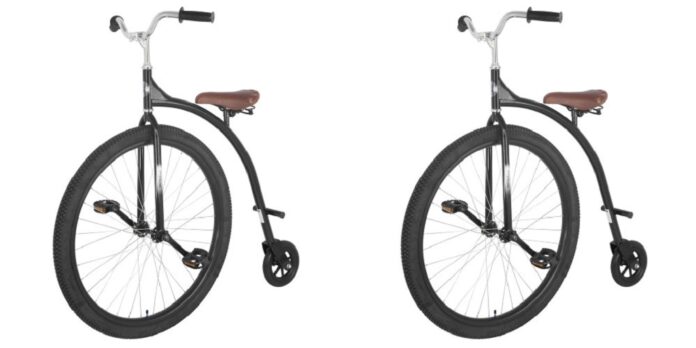Have you ever seen one of those odd bikes with a large front wheel and a small rear wheel?
There are a bunch of photos of these odd bikes next to gentlemen in dapper garb from the Victorian era, which fronts an even more whimsical picture.
They’re called penny farthing bikes, by reason of the larger front wheel and smaller rear wheel which, next to each other resemble a penny and a farthing, which is a small sterling coin, no longer in circulation, which was equivalent to a quarter of a penny.
Yet, despite the fact that these might seem like clown bikes, they’re very real machines. Here are a few things you should know about them, especially if you are planning on buying one.
- These were the fastest vehicles on the road in their day. Don’t let your preconceived notions on these things rule your reason. Late in the 1800s, when these odd bikes were introduced they were the fastest things on the roads, faster than horses, and faster than early cars. They might look like clown bikes, but they delivered on performance and represented a significant leap in technology when compared to other early bikes.
- They take some special skill to ride. Riding a “penny” as they are called requires some special skill and it is not entirely like riding a “regular” bike. You’ll need to learn how to mount and dismount, along with how to brake and steer. Because all of the proportions of these bikes are wildly exaggerated compared to modern bikes, they can take some getting used to.
- You need to be very careful when riding. Braking, in particular, requires special care and attention, because if you attempt to brake too hard, you’ll just drag the rear wheel rather than slowing down the bike. Also, if you brake too abruptly, or stop short, you might get pitched over the handlebars.
- Speed is determined by the size of the front wheel. These are primitive bicycles and do not have a chain drive system. As a result, the top speed of any given penny farthing is a product of the diameter of the front wheel, to which the crank arms are attached. The bigger the wheel, the faster the bike can ride, all else being equal.
- There are no shocks or suspension. Though the main focus of the larger front wheel is on engendering a higher potential top speed, the larger wheel size also means that these bikes are better able to handle the dips and bumps of a rough road. It also represents a development of the penny farthing over its predecessor, the velocipede, which had smaller wheels and which was known as the “boneshaker.” You might be able to imagine why.
- Your height will determine the size of the bike you can ride. Because these bikes have really big front wheels and crank arms fixed directly to the hub axle, your inseam length will determine the largest size that you can ride. If you’re very short, there are some penny farthings that might just be too large for you – you will need to stick with a smaller model.
Want to Learn More About These Odd Bikes?
Are you potentially interested in getting one of these odd bikes for your collection? You can learn more about them and other odd bikes, even clown bikes and mini bikes, over at Unicycle.com.
Visit their website and if you have any questions about anything they sell, or need recommendations, get in touch with them directly.





